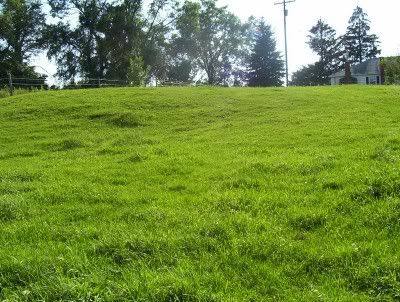
Today part of my chores included walking the pastures...checking for fences that may need repair, digging up thistles and burdock before they get a chance to take hold and spread, and looking for dangers that may be hidden that cause trouble for the livestock. This is an important part of farm management and it is not really right to call it a chore, for I do enjoy it.
Sheep are excellent foragers (see the photo at the beginning of this post? That is not my lawn but one of the sheep pastures!) Horses are not so good. Compare the picture below of the horses walking through knee deep forage that they haven't touched in their pasture to the smooth, even grazing of the sheep (above)

Ideally, the sheep would rotate through the pastures behind our horses, but our fence system is not set up that way - maybe one day. So for now, they are in different parts of the farm. The horses leave huge areas of uneaten plant stuff and that means spending time and gas money running the tractor and brush hog to clip those pastures. Were we able to run the sheep behind them, they would clean this up, serving two purposes. Fatten up the sheep and clean up the pastures (making money and saving money, all at the same time! Are you beginning to see the good sense that good farming practices make?)
I am fortunate to have four pasture lots to rotate my sheep through, and three main pastures for the horses. This helps keeps the sheep lots clean and growing and reduces the parasite load (worms) that occur when livestock is allowed to over graze. I have also been fortunate to have my dad build the pasture fences for me. Fence building is a lost skill and knowledge for the most part, but my dad and brothers know it. Dad is teaching Alex the skill. A good fence, well built, can last the lifetime of a farmer.
We fight Canadian thistle in our pastures and hay fields. It starts mostly along fence rows where I suppose the birds perch and leave behind seeds of the weed. In the spring, when the plant is tender and green, the sheep keep it under control...it is their favorite part of the pasture smorgasbord! But towards the middle of July, the thistle plant must start to toughen up because they stop eating even the smallest sprout and it will get away from us and reseed if we are not diligent. I don’t use chemical sprays to control this weed - I mow it down before it sets seed. The giant Bull Thistle, too, is not sprayed but is dug by hand while it is small, to prevent spreading.
Photo below - preventing the spread of Bull Thistle (see the dead thistle?)
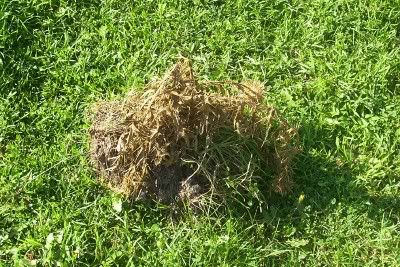
Now this photo (below) is what happens when the diligent farmer (me) misses a thistle sprout in the fence row and it gets out of hand (that thisle is nearly six foot tall!):
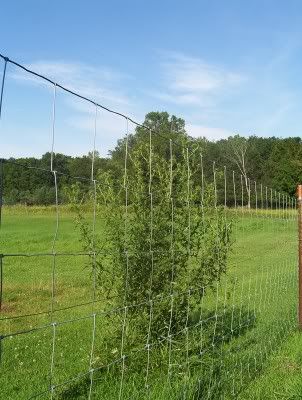
Other weeds need to be watched for. I was reminded of the importance of these pasture walks when I discovered a fairly large patch of uneaten forage in the middle of the ewes main lot. I thought it odd that they had obviously not touched this area, and I was relieved when I discovered that what they hadn’t been eating was deadly Nightshade growing in this area!
Nightshade is toxic to sheep and it grows on our ground, though not rampantly. I usually manage to stay ahead of it. Now here it was in an area it had not been seen before, dozens of little healthy plants sprouted. How did the sheep know not to eat it? They will eat it, I know they will. Maybe because we have had plenty of rains this year and the rest of their pasture remains lush...they just didn’t touch it. For whatever reason, I was glad they hadn’t gotten into it and that I was able to fence them out of this pasture while I get control of the dangerous weed. You can do a Google search for photos and information about Nightshade and other toxic plants.
Another part of pasture management is keeping overgrown vegetation mowed or clipped, as I mentioned before. This helps keep it fresh and weeds from going to seed. Below you see the newest pasture for the ewes. This had been horse pasture and was badly overgrown. After Dad and Alex finished the fencing, Bill clipped the overgrown stuff and the brood ewes were moved to their new summer grazing.
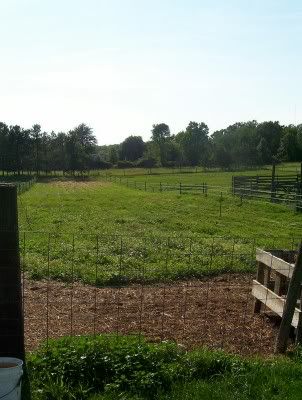
Healthy pasture, and plenty of it, is a good thing! Below you will see I have just opened a gate allowing the girls into a fresh pasture. They barely get into it before they begin their grazing!

Manure management is another part of farming with livestock. Though some folks don't like to think about this by-product of any farm animal (manure), it is a fact of life. We are a small family farm, using traditional methods to care for our land and that includes handling manure in one of two ways. The first is to spread it back on the hay and crop ground as fertilizer. The second is to compost it into lovely stuff to feed my sad, sandy soil! Sheep manure is excellent fertilizer, being higher in nitrogen, phosphorus and potash than either horse or cow manure. It contains many of the valuable elements taken from the soil by the plants eaten by sheep.

The giant five foot high manure pile in the picture above will break down to half its size and be welcome supplement to my gardens. By the way, the manure/compost pile is NOT as close to the sheep pastures as it appears in this photo.
And finally, what makes me REALLY happy???
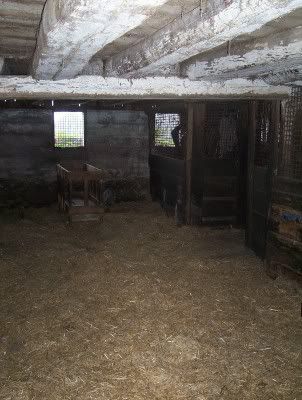
A clean barn, freshly bedded...a welcome haven for sheep and shepherd alike! I love this picture of the old basement of the barn - the sheep pen. In winter the sheep snuggle here for warmth and in summer they lay against the cool stones. It is bright and dry, something else that is important for healthy animals.
5 comments:
I enjoyed reading about what you do on your farm. I'm not a city girl but I didn't grow up farming either and so I don't know all the ins and outs of what goes into raising your lovely wool and caring for you horses. I love seeing all your animals and it delights me that Alex is learning these things too!
Okay, now I want 150 acres instead of my 5. Great post. Please do more on farming, like how to build those fences perhaps. . . ???
Cary, your post makes me want to move to the country. What beautiful, well-kept pastures and critters! I was brought up by country parents and think it is in the genes.
Cary,
I love seeing what you do on your farm. It makes me long for one someday!
Thanks for the sweet comments you guys! I love farm life, with all its ups and downs, and hope to live out all of my days on a farm.
Deborah, I think I should have my dad make a video of fence building!
Post a Comment